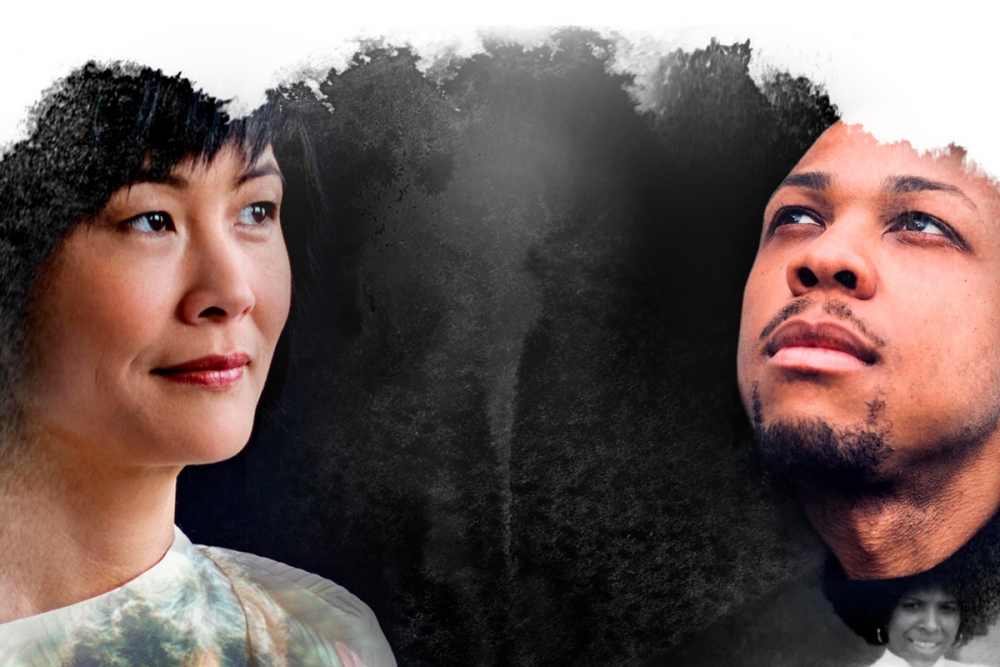
Everything Rises
In a chance encounter at the Paris Opera, standing yards apart, Jennifer Koh and Davóne Tines formed an instant bond: they were the only two people of color in the crowd. They locked eyes, met, spoke — and have been tightly connected ever since.
Finding in one another a kindred spirit and an ally, classical violinist Koh and classical vocalist Tines also soon discovered they had a common vision: to foster connection and resonance in a new artistic space. Such was the spark for an innovative collaboration that has now come to fruition.
In a piece co-commissioned by UC Santa Barbara Arts & Lectures and ARCO Collaborative, Koh and Tines for the first time will stage their original musical and multimedia piece about reclaiming agency through ancestral memory. “Everything Rises” will premiere at 8 p.m. Tuesday, April 12, at Campbell Hall. A Q&A with the artists will follow their performance.
“A long-standing artist with A&L, Jennifer Koh is one of today’s most skilled violinists and a creative mind who makes surprising and potent connections through her music,” said A&L’s Miller McCune Executive Director Celesta M. Billeci. “We are proud to commission Everything Rises, her new project with another visionary artist, Davóne Tines. Koh and Tines are both commanding artists in their own right, lauded not only for their immense talent but also for using their art to push their fields — and our culture — forward.”
A world-renowned violinist and Grammy winner, Koh is a forward-thinking artist dedicated to exploring a broad and eclectic repertoire. Bass-baritone Tines blends opera, spirituals, gospel and songs of protest to tell a deeply personal story of perseverance that connects to all of humanity.
Their project is both a record and artistic product of their first encounter and the realization of their shared struggle: being an artist of color in a culture dominated by whiteness. On stage, their collective exploration delves into their respective family histories, from the experiences of Koh’s mother during the Korean War and immigrating to the U.S., to those of Tines’s grandmother with anti-Black discrimination and violence.
Ultimately, “Everything Rises” asks what it would take for this grief, frustration and anger to truly be heard.
“This work is about Davóne and I being able to give each other the space — and the creative space — to tell our own stories,” Koh said in a recent webinar about the piece. “I think one thing that is unique about this work is that it shows the long history of Afro-Asian alliance in this country.”
Aiming to reclaim the artists’ narratives about who they are, how they got here and how this work came to be, “Everything Rises” was created by a team of Black, Indigenous and people of color. Through music, projections and recorded interviews, it centers the need for artists of color to be seen and heard through connection and the creation of a new artistic space.
“The piece overall is a telling of Jenny and I meeting each other as classical musicians of color in a generally white world or white space — the story of us getting to know each other through telling our family histories, sharing the depths and breadth of our experiences as classical performers of color and seeing the commonalities, the differences,” said Tines, “and the larger context of our own current existence so we can understand our trajectory from the past in order to find out … how can we move forward together with more understanding.”
Everything Rises is an event of A&L’s continuing series Justice for All and part of its yearlong programmatic initiative, Creating Hope. It is produced by ARCO Collaborative and presented in association with the UCSB Department of Music and the UCSB MultiCultural Center.
Said Billeci, “Arts & Lectures is honored to be able to support this powerful, complex collaboration that sheds light on our collective heritage as individuals and as a nation, bringing together our past, our present, and perhaps most poignantly, our future.”



